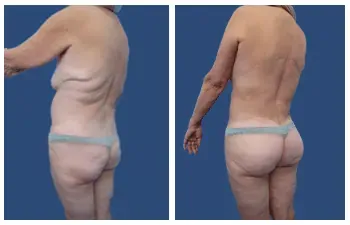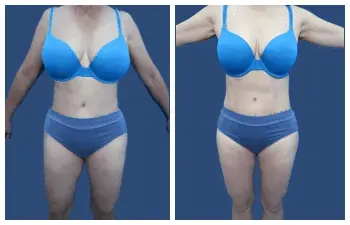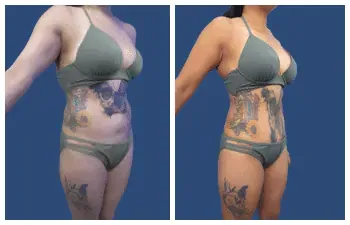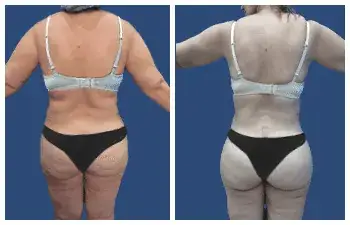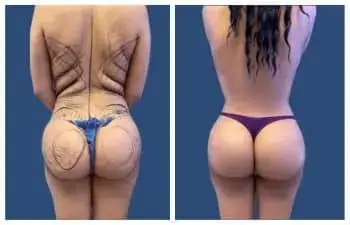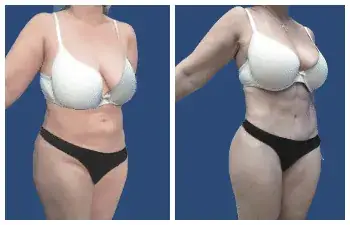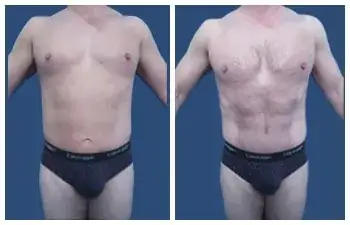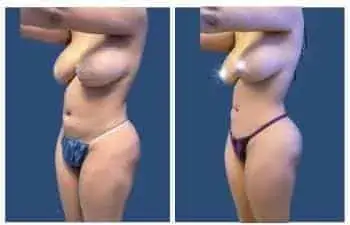
Introduction: What to expect 4 weeks after Liposuction
What to expect 4 weeks after liposuction? Liposuction is a common and effective cosmetic procedure used to reduce areas of fat accumulation and improve body contours. Patients need to understand what to expect when undergoing liposuction in terms of the healing process and long-term results. This article will summarize what we can expect four weeks after a liposuction procedure and tips on how best to manage any discomfort or risks during this time.
The healing process following liposuction differs for everyone, depending on age, health status, and lifestyle habits. Most patients experience certain milestones in the first four weeks post-surgery, which you should consider before pondering additional treatments. At this stage of recovery, swelling may still be present but should have diminished significantly from its peak immediately after surgery. Bruising may remain visible, and it could take several more days or weeks to disappear completely.
It is essential for anyone who has recently undergone liposuction to follow their doctor’s instructions closely to ensure a safe and successful recovery. Some activities, such as strenuous exercise, should be avoided until all symptoms associated with the procedure have subsided fully. Besides following these guidelines carefully, close monitoring of one’s overall health by both the patient and medical professional is advised throughout the entire duration of postoperative care.
What To Expect Liposuction After 4 Weeks
Liposuction is an artful procedure that achieves spectacular results in sculpting the body. It involves removing fat from areas of the body where it has become stubbornly resistant to diet and exercise, creating a more contoured silhouette. Liposuction results week by week will evolve. After liposuction, liposuction recovery time will vary depending on several factors. Swelling after liposuction, After four weeks post-procedure, most patients can expect significant improvements in their appearance.
The recovery period after liposuction typically lasts between three and six weeks. During this time, swelling and bruising will gradually fade as the newly reshaped area heals. Some people may experience numbness or tingling due to nerve damage caused by the surgical process; however, these sensations usually resolve within two months of surgery. Compression garments should be worn for at least four to six weeks following the operation to reduce bleeding and inflammation while aiding healing. Compression garments also help maintain smooth skin texture during recovery.
What to Expect Immediately After Surgery
Following liposuction surgery, it is normal to feel discomfort and soreness in the treated area. Swelling and bruising are common side effects of this procedure, which may take up to four weeks to subside. Immediately after the operation, a compression garment must be worn for approximately two weeks or more, depending on your circumstances. Compression will help reduce swelling and support the newly contoured areas during recovery.
Your surgeon will probably recommend that you avoid strenuous activities for at least one week after the surgery but can continue with light walking as tolerated. During this period, you may experience fluid drainage from the incision sites; if so, special pads must absorb the fluid and protect your skin. It’s important to keep these clean and dry until they heal completely. Your physician may also prescribe antibiotics or pain medications if needed. Proper rest is essential while recovering from liposuction surgery to promote healing and prevent complications, such as infection or excessive bleeding.
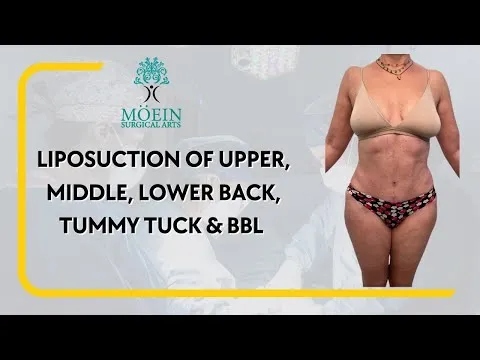
Recovery Process Liposuction What to Expect

Patients who have undergone liposuction can expect to experience some swelling and bruising during the first four weeks after their procedure. This bruising is a normal part of recovery and usually subsides within 4-6 weeks. Pain levels should remain relatively low, but patients may require over-the-counter or prescription medication for more intense discomfort.
Dressings placed during surgery must be changed regularly to keep wounds clean and dry. Patients need to follow postoperative instructions from their surgeon regarding activity restrictions, wound care, and other special instructions. After about four weeks, most patients can gradually return to physical activities as directed by their surgeon. Patients should consult with their doctor before beginning any exercise program following liposuction. Proper rest and care can speed up healing and significantly reduce recovery time.
Pain and Discomfort after Liposuction
After four weeks of liposuction recovery, it is normal to feel pain and discomfort still. The intensity of these symptoms should have decreased significantly since the initial procedure. Thus, one may wonder – How much pain and discomfort can be expected after four weeks?
Most people will experience a gradual decrease in postoperative pain over this period. Manage any residual soreness or tenderness during the healing process; patients are encouraged to follow their doctor’s instructions regarding medications, rest periods, and physical activity levels. It is also important to note that there may be areas around incision sites where swelling persists for up to several months. Patients should contact their healthcare provider if they notice unusual redness or swelling throughout recovery.
Recovering from liposuction surgery requires patience and adherence to prescribed protocols; however, with proper care and attention, individuals should expect relief from pain and other discomforts within four weeks following the procedure.
Healing Time
The healing process after liposuction can vary from person to person. Four weeks post-procedure is considered a significant milestone in the recovery process. Most patients will have seen a noticeable improvement in their body shape and feel much better overall.
It is normal for some swelling to remain at this stage of recovery; however, it should subside over the next few weeks as long as proper postoperative care instructions are followed. Patients may also experience tenderness or soreness around the incision sites and areas treated with liposuction. This discomfort usually resolves within two to three weeks but can take up to six months before subsiding completely. Patients must follow their healthcare provider’s advice regarding activity level during this period so they do not put undue strain on the affected area, which could delay healing time.
Post-Surgery Care Liposuction Instructions
At four weeks post-surgery, patients undergoing liposuction should expect to heal. After their initial recovery period, they will need to follow instructions for proper care and management of their surgical site to ensure optimal results.
Patients should monitor any signs of infection or inflammation, such as redness, swelling, tenderness, and discharge. These symptoms show an infection that could worsen if left unchecked. The patient’s doctor may prescribe antibiotics or other medications for these infectious conditions. The patient must refrain from smoking and engaging in heavy lifting or straining activities during this time frame.
Regular moisturizing with quality products is strongly recommended to minimize scarring after surgery and keep skin healthy. In addition, the use of compression garments is highly encouraged for both comfort and support while providing adequate pressure on incision sites; wearing them 24 hours per day helps reduce swelling and encourages quicker healing. Sun exposure must be minimized since tanning speeds up aging and damages already sensitive skin even further. Remembering these simple steps can help maximize the outcome of your liposuction procedure!
Activity Restrictions After Liposuction
Activity restrictions after liposuction should be followed for four weeks. It is important to refrain from strenuous physical activity such as running, weight lifting, and sports requiring high-intensity movements during this time frame. Activities that involve bending or stretching need to be avoided to minimize the risk of complications. Patients may experience discomfort because of swelling or bruising during this period, so light exercises such as walking are encouraged; however, only if they do not cause pain. The patient can resume their daily routine after four weeks, but should still avoid heavy exertion and seek medical advice if necessary. Patients must adhere strictly to these activity restrictions for successful recovery without further risks or damage.
Long-Term Results
What to expect 4 weeks after liposuction? Dramatic results of liposuction after just four weeks can be nothing short of astounding. It seems too good to be true; the surgical removal of fat cells results in a more contoured body shape and improved self-esteem for patients with stubborn fatty deposits resistant to diet and exercise. But what about long-term effects? After all, one must consider the potential risks of cosmetic surgery.
Fortunately, liposuction is considered a safe procedure when performed by an experienced physician under proper medical conditions. Studies show that long-term results are maintained over time as long as the patient maintains their weight within 10% of preoperative levels and physical activity remains consistent. Any new or recurring fat accumulation can be treated again if necessary. There may also be some minor skin irregularities, such as unevenness or dimpling. Still, these typically improve over time, given regular massage therapy, topical creams, and gels prescribed by your doctor.
Liposuction effectively achieves a desired aesthetic goal while minimizing risk factors for those who meet certain criteria. When ensuring success, it’s important to remember realistic expectations and discuss them thoroughly with your cosmetic surgeon before undergoing treatment. – this will help maximize your chances of satisfaction with the outcome.
Risks of Liposuction

Liposuction is a safe procedure; however, there are some associated risks. These include infection, excessive bleeding, bruising, nerve damage or numbness in treatment, an asymmetry between treated areas, skin discoloration, and contour irregularities. Most of these complications can be avoided by having the surgery by an experienced professional with proper technique.
Patients may also experience temporary swelling, pain, tenderness, and soreness for several weeks after the procedure. The anesthetic used during liposuction can cause reactions ranging from mild to severe, such as nausea, dizziness, and headaches. Patients should always consult their doctor if they develop any unusual symptoms post-procedure. In rare cases, serious complications such as fat embolism or deep vein thrombosis have been reported following liposuction. Still, they can usually be prevented through thorough preoperative assessment and close monitoring of patients during recovery.
Benefits of Liposuction
The benefits of liposuction are many. It is a safe, minimally invasive procedure that can provide dramatic results in only one session. The fat cells removed during the procedure do not regenerate, so patients enjoy long-lasting improvements to their body shape, which they may have thought impossible before. Many individuals find increased self-confidence and improved physical well-being by removing excess fat from areas such as the abdomen, hips, buttocks, thighs, and arms.
Recovery time varies between patients, but after four weeks, most people can resume normal activities with minor discomfort or downtime. During this period, individuals must follow their doctor’s advice on managing postoperative pain and ensure minimal scarring. With proper care, see gradual improvement over subsequent months, with your ultimate result becoming more noticeable around six months following surgery.
Conclusion: What to expect 4 weeks after Liposuction
Understanding the risks and benefits of liposuction before undergoing the procedure is important. Liposuction can be a very effective way to contour your body, but it also carries potential risks and requires some downtime for recovery. After four weeks, most patients have recovered from their surgery and can resume normal activities with minimal discomfort or pain. There will probably still be swelling in treated areas; however, any noticeable changes should appear as healing progresses.
Liposuction can provide excellent results when performed correctly by an experienced surgeon. It’s paramount for individuals considering this procedure to do extensive research on their doctor before committing to having the operation done. By taking these precautions, you can ensure positive outcomes and peace of mind, knowing you receive quality care in a safe environment.
Ultimately, it cannot be overstated how beneficial liposuction has been for countless people worldwide who seek aesthetic improvements, making them feel more confident and content with their appearance -a boon they may not have achieved otherwise.

